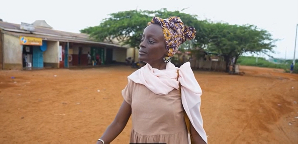 Lea Kilenga, lady who survived sickle cell disease and its stigma
Lea Kilenga, lady who survived sickle cell disease and its stigma
Three of the four siblings in Lea Kilenga’s family were born with sickle cell, including Lea. Her eldest sister passed away from the disease when she was just 4 years old. Kilenga herself was told that she would not live beyond her 8th birthday.
Sickle cell is an inherited and debilitating blood disorder that causes normal round red blood cells – which carry oxygen through the body – to become crescent-shaped and rigid. These misshapen cells can block blood flow to vital organs and lead to serious complications, including stroke, blood clots, anemia, and bouts of extreme pain.
“You’re frequently in pain. And they say by the time you’re 40 you have at least one organ that is extensively damaged,” said Kilenga, who grew up in Taveta, Kenya. “(The disease) is something that I would not wish for anyone.”
Of the 120 million people worldwide living with sickle cell, more than 66% are in Africa. Despite the prevalence, treatment to relieve pain and prevent complications is difficult to secure, and stigma against the disease is widespread, even associated with witchcraft in rural areas.
“Sickle cell affects more lower resource communities where there’s a large financial burden to access medicine and health care,” Kilenga said.
Kilenga has fought her whole life to overcome the challenges of living with the disease, and she is on a mission to help thousands of other sickle cell patients get the medical care they need to lead fulfilling lives. Through her nonprofit, Africa Sickle Cell Organization, she is breaking down stigmas and bringing treatment that was once only available in wealthy Western countries to sub-Saharan Africa.
“My parents protected us from stressors, educated themselves, and allowed us to grow and to thrive,” Kilenga said. “The challenges we faced in a home of people living with sickle cell was the merry-go-round of pain and hospitals and medicine. It was how we grew up.”
After graduating from university, Kilenga decided to travel the country taking photographs of people with sickle cell and interviewing them and their families about their struggles with it. Initially, she planned to photograph and interview 10,000 people. But after the horrors she encountered on the project, she stopped at 400.
She found sick children locked in rooms, crying incessantly for help yet ignored by family members who had no idea what to do. Kilenga said so many families had no understanding of how to care for their sick children and thought it would be better to let them die. The people she met throughout Kenya didn’t have access to any medical care or pain management. There were 4-year-old children who looked 1 year old because of poor growth development from a lack of treatment.
“When I went on the ground, the reality was worse than I could have imagined,” Kilenga said. “I could no longer do it because it was just so sad. I decided I had to share this pain with someone who could do something about it.”